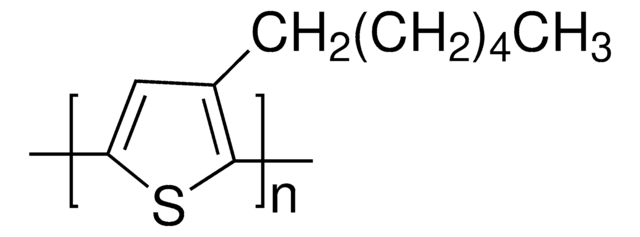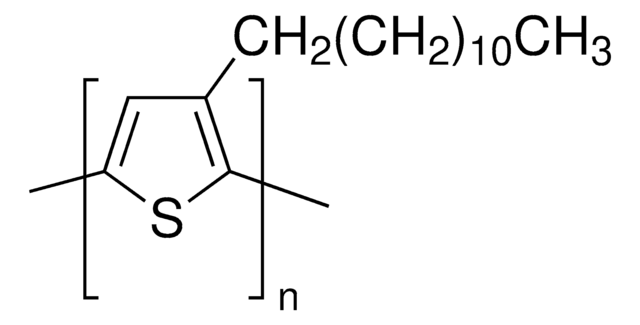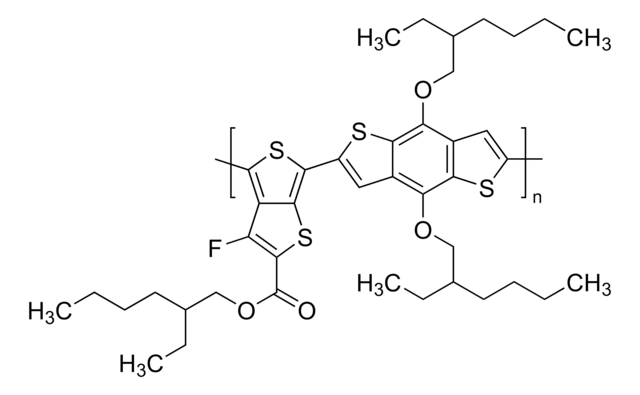Regioregular means all of the monomer units are in the same orientation. E.g. if you think of each monomer unit as your palm, regioregular would have all palms facing away, fingers up - all in same orientation. (Regiorandom might have one pointing up, one pointing down, one with palms facing you, one with palms facing away, etc, all in a row.)
Wichtige Dokumente
445703
Poly(3-hexylthiophen-2,5-diyl)
regioregular
Synonym(e):
P3HT
Größe auswählen
Größe auswählen
About This Item
Empfohlene Produkte
Qualitätsniveau
Mol-Gew.
average Mw 50,000-100,000
Grünere Alternativprodukt-Eigenschaften
Design for Energy Efficiency
Learn more about the Principles of Green Chemistry.
sustainability
Greener Alternative Product
Leitfähigkeit
~103 S/cm (when doped with iodine)
mp (Schmelzpunkt)
238 °C
238 °C
Fluoreszenz
λex 443 nm; λem 568 nm in chloroform
Energie der Orbitale
HOMO 5 eV
LUMO 3 eV
Leistung von OPV-Bauelementen
ITO/NiO/P3HT/PC61BM/LiF/Al
- Short-circuit current density (Jsc): 11.3 mA/cm2
- Open-circuit voltage (Voc): 0.64 V
- Fill Factor (FF): 0.69
- Power Conversion Efficiency (PCE): 5.16 %
ITO/PEDOT:PSS/P3HT:PC61BM (1:08)/Al
- Short-circuit current density (Jsc): 9.5 mA/cm2
- Open-circuit voltage (Voc): 0.63 V
- Fill Factor (FF): 0.68
- Power Conversion Efficiency (PCE): 5 %
Grünere Alternativprodukt-Kategorie
Halbleitereigenschaften
P-type (mobility=1E-4-1E-1 cm2/V·s)
Suchen Sie nach ähnlichen Produkten? Aufrufen Leitfaden zum Produktvergleich
Allgemeine Beschreibung
Anwendung
Leistungsmerkmale und Vorteile
Gute Verarbeitbarkeit, Umweltstabilität und Elektroaktivität.
Verpackung
Rechtliche Hinweise
Rieke ist eine eingetragene Marke von Rieke Metals, Inc.
Lagerklassenschlüssel
11 - Combustible Solids
WGK
WGK 3
Flammpunkt (°F)
Not applicable
Flammpunkt (°C)
Not applicable
Persönliche Schutzausrüstung
dust mask type N95 (US), Eyeshields, Gloves
Hier finden Sie alle aktuellen Versionen:
Analysenzertifikate (COA)
Die passende Version wird nicht angezeigt?
Wenn Sie eine bestimmte Version benötigen, können Sie anhand der Lot- oder Chargennummer nach einem spezifischen Zertifikat suchen.
Besitzen Sie dieses Produkt bereits?
In der Dokumentenbibliothek finden Sie die Dokumentation zu den Produkten, die Sie kürzlich erworben haben.
Kunden haben sich ebenfalls angesehen
Artikel
Flexible electronic circuits and displays based on organic active materials are future generations of products that may eventually enter mainstream electronics market.
PCBM-based n-type semiconductors - Find p- and n-type organic semiconductors available with PCBM library & properties.
Flexible electronic circuits, displays, and sensors based on organic active materials will enable future generations of electronics products that may eventually enter the mainstream electronics market.
The application of conducting polymers at the interface with biology is an exciting new trend in organic electronics research.
-
For Product 445703, Poly(3-hexylthiophene-2,5-diyl), what does regioregular mean?
1 answer-
Helpful?
-
-
For Product 445703, Poly(3-hexylthiophene-2,5-diyl), what does "diyl" refer to?
1 answer-
The use of "diyl" is simply an extension of the use of the "yl" ending for a single substituent. For example, a monosubstituted ethane becomes ethyl - - - -, a monosubstituted propane becomes propyl - - - -, a monosubstituted butane becomes butyl - - - - and so on. Similarly, a 1,3-disubstituted butane becomes 1,3-butanediyl, indicating the presence of similar substituents on the 1- and 3- positions of the butane portion of the molecule.
Helpful?
-
-
For product 445703, Poly(3-hexylthiophene-2,5-diyl), what are the end groups for the polymer? What is the initiator for the polymerization?
1 answer-
For product 445703, Poly(3-hexylthiophene-2,5-diyl), one end group is a hydrogen and the other end group is a bromine. The name of the initiator for the polymerization is proprietary information.
Helpful?
-
-
What is the Department of Transportation shipping information for this product?
1 answer-
Transportation information can be found in Section 14 of the product's (M)SDS.To access the shipping information for this material, use the link on the product detail page for the product.
Helpful?
-
-
What percentage is regioregular in Product 445703, Poly(3-hexylthiophene-2,5-diyl)?
1 answer-
Based on proton NMR, it is estimated to be approximately 98% regioregular.
Helpful?
-
-
What is the molecular weight of Product 445703, Poly(3-hexylthiophene-2,5-diyl)?
1 answer-
The molecular weight (MW) is approximately 87,000.
Helpful?
-
-
What is Product 445703, Poly(3-hexylthiophene-2,5-diyl), soluble in?
1 answer-
This product will be soluble in Carbon Tetrachloride, Chloroform, and Dichloromethane. It is also partially soluble in Tetrahydrofuran, ether and slightly soluble in Toluene.
Helpful?
-
Active Filters
Unser Team von Wissenschaftlern verfügt über Erfahrung in allen Forschungsbereichen einschließlich Life Science, Materialwissenschaften, chemischer Synthese, Chromatographie, Analytik und vielen mehr..
Setzen Sie sich mit dem technischen Dienst in Verbindung.

![[6,6]-Phenyl C61 Buttersäuremethylester ≥99%](/deepweb/assets/sigmaaldrich/product/structures/359/221/d990c746-0960-4c69-bf76-fe09b193824d/640/d990c746-0960-4c69-bf76-fe09b193824d.png)






